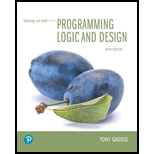
Starting Out with Programming Logic and Design (5th Edition) (What's New in Computer Science)
5th Edition
ISBN: 9780134801155
Author: Tony Gaddis
Publisher: PEARSON
expand_more
expand_more
format_list_bulleted
Textbook Question
Chapter 6, Problem 10PE
Prime Numbers
A prime number is a number that is only evenly divisible by itself and 1. For example, the number 5 is prime because it can only be evenly divided by 1 and 5. The number 6, however, is not prime because it can be divided evenly by 1, 2, 3, and 6.
Design a Boolean function named isPrime, which takes an integer as an argument and returns True if the argument is a prime number, or False otherwise. Use the function in a
Expert Solution & Answer
Want to see the full answer?
Check out a sample textbook solution
Students have asked these similar questions
Dijkstra's Algorithm (part 1). Consider the network shown below, and Dijkstra’s link-state algorithm. Here, we are interested in computing the least cost path from node E (note: the start node here is E) to all other nodes using Dijkstra's algorithm. Using the algorithm statement used in the textbook and its visual representation, complete the "Step 0" row in the table below showing the link state algorithm’s execution by matching the table entries (i), (ii), (iii), and (iv) with their values. Write down your final [correct] answer, as you‘ll need it for the next question.
4. |z + 5 - 5i| = 7
14.
dz,
C: |z❘
C: |z❘ = 0.6
ze² - 2iz
H
Chapter 6 Solutions
Starting Out with Programming Logic and Design (5th Edition) (What's New in Computer Science)
Ch. 6.1 - How does a function differ from a module?Ch. 6.1 - Prob. 6.2CPCh. 6.1 - Prob. 6.3CPCh. 6.1 - In pseudocode, what does the following statement...Ch. 6.1 - In pseudocode, what does the following statement...Ch. 6.2 - What is the purpose of the Return statement in a...Ch. 6.2 - Look at the following pseudocode function...Ch. 6.2 - What is a Boolean function?Ch. 6 - This is a prewritten function that is built into a...Ch. 6 - This term describes any mechanism that accepts...
Ch. 6 - This part of a function definition specifies the...Ch. 6 - This part of a function definition is comprised of...Ch. 6 - In pseudocode, this statement causes a function to...Ch. 6 - This is a design tool that describes the input,...Ch. 6 - This type of function returns either True or...Ch. 6 - This is an example of a data type conversion...Ch. 6 - Prob. 9MCCh. 6 - Prob. 10MCCh. 6 - The code for a library function must appear in a...Ch. 6 - Prob. 2TFCh. 6 - In many languages it is an error to assign a real...Ch. 6 - In some languages you must use a library function...Ch. 6 - Prob. 5TFCh. 6 - What is the difference between a module and a...Ch. 6 - Prob. 2SACh. 6 - Prob. 3SACh. 6 - Prob. 4SACh. 6 - Prob. 5SACh. 6 - Prob. 6SACh. 6 - As shown in this chapter, write a pseudocode...Ch. 6 - The following pseudocode statement calls a...Ch. 6 - A pseudocode program contains the following...Ch. 6 - Design a pseudocode function named timesTen that...Ch. 6 - Design a pseudocode function named getFirstName...Ch. 6 - Assume that a program has two String variables...Ch. 6 - The programmer intends for this pseudocode to...Ch. 6 - Can you find the reason that the following...Ch. 6 - Can you find the reason that the following...Ch. 6 - Feet to Inches One foot equals 12 inches. Design a...Ch. 6 - Math Quiz Design a program that gives simple math...Ch. 6 - Maximum of Two Values Design a function named max...Ch. 6 - Falling Distance When an object is falling because...Ch. 6 - Kinetic Energy In physics, an object that is in...Ch. 6 - Test Average and Grade Write a program that asks...Ch. 6 - Odd/Even Counter In this chapter you saw an...Ch. 6 - Guess the Number Design a number guessing game...Ch. 6 - Prime Numbers A prime number is a number that is...Ch. 6 - Prime Number List This exercise assumes you have...Ch. 6 - Rock, Paper, Scissors Game Design a program that...Ch. 6 - Prob. 13PECh. 6 - ESP Game Design a program that tests your ESP, or...
Knowledge Booster
Learn more about
Need a deep-dive on the concept behind this application? Look no further. Learn more about this topic, computer-science and related others by exploring similar questions and additional content below.Similar questions
arrow_back_ios
SEE MORE QUESTIONS
arrow_forward_ios
Recommended textbooks for you
 C++ for Engineers and ScientistsComputer ScienceISBN:9781133187844Author:Bronson, Gary J.Publisher:Course Technology Ptr
C++ for Engineers and ScientistsComputer ScienceISBN:9781133187844Author:Bronson, Gary J.Publisher:Course Technology Ptr C++ Programming: From Problem Analysis to Program...Computer ScienceISBN:9781337102087Author:D. S. MalikPublisher:Cengage LearningProgramming Logic & Design ComprehensiveComputer ScienceISBN:9781337669405Author:FARRELLPublisher:Cengage
C++ Programming: From Problem Analysis to Program...Computer ScienceISBN:9781337102087Author:D. S. MalikPublisher:Cengage LearningProgramming Logic & Design ComprehensiveComputer ScienceISBN:9781337669405Author:FARRELLPublisher:Cengage Microsoft Visual C#Computer ScienceISBN:9781337102100Author:Joyce, Farrell.Publisher:Cengage Learning,
Microsoft Visual C#Computer ScienceISBN:9781337102100Author:Joyce, Farrell.Publisher:Cengage Learning, Programming with Microsoft Visual Basic 2017Computer ScienceISBN:9781337102124Author:Diane ZakPublisher:Cengage Learning
Programming with Microsoft Visual Basic 2017Computer ScienceISBN:9781337102124Author:Diane ZakPublisher:Cengage Learning EBK JAVA PROGRAMMINGComputer ScienceISBN:9781337671385Author:FARRELLPublisher:CENGAGE LEARNING - CONSIGNMENT
EBK JAVA PROGRAMMINGComputer ScienceISBN:9781337671385Author:FARRELLPublisher:CENGAGE LEARNING - CONSIGNMENT

C++ for Engineers and Scientists
Computer Science
ISBN:9781133187844
Author:Bronson, Gary J.
Publisher:Course Technology Ptr

C++ Programming: From Problem Analysis to Program...
Computer Science
ISBN:9781337102087
Author:D. S. Malik
Publisher:Cengage Learning

Programming Logic & Design Comprehensive
Computer Science
ISBN:9781337669405
Author:FARRELL
Publisher:Cengage

Microsoft Visual C#
Computer Science
ISBN:9781337102100
Author:Joyce, Farrell.
Publisher:Cengage Learning,

Programming with Microsoft Visual Basic 2017
Computer Science
ISBN:9781337102124
Author:Diane Zak
Publisher:Cengage Learning

EBK JAVA PROGRAMMING
Computer Science
ISBN:9781337671385
Author:FARRELL
Publisher:CENGAGE LEARNING - CONSIGNMENT
.2: Function Parameters and Arguments - p5.js Tutorial; Author: The Coding Train;https://www.youtube.com/watch?v=zkc417YapfE;License: Standard Youtube License